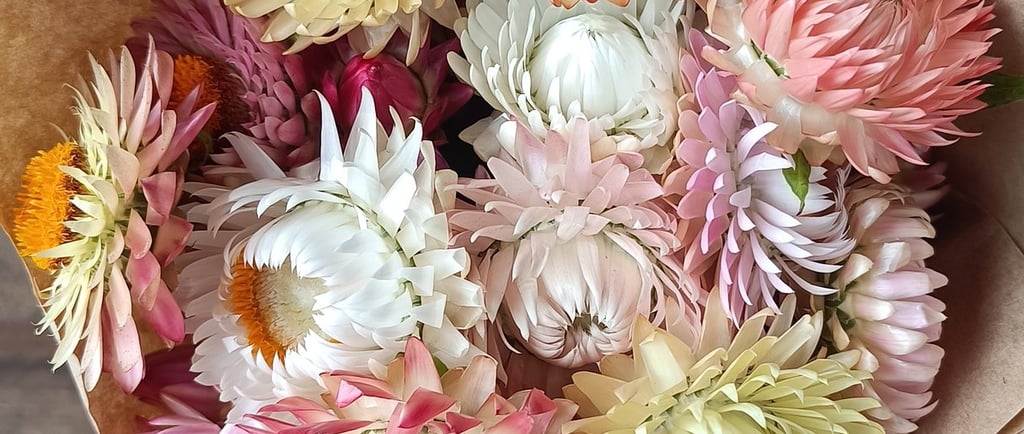Growing your own wildflowers
Guide to growing some of our favorite wildflowers from seed to posy
9/2/20253 min read


It’s hard to believe we’re already in our third growing season here at Freestone Flora. Some of the flowers we’ve released in seed packets are long-time favorites we’ve grown for years, while others are exciting new varieties we’ve been trialing more recently.
Below, I’ve shared some of our best tips for growing these species, shaped from both successes and lessons learned All of our seed varieties can be grown either in trays or by using the scatter method. Each has its pros and cons, and we often switch between the two depending on the season and conditions.
Scatter Method
This is the most low-effort way to grow flowers—perfect if you’re happy to take an “if they grow, they’ll grow” approach. Simply prepare a garden bed or patch of soil where you’d like flowers to appear, then scatter the seeds directly. There’s no transplanting, potting mix, or special tools required.
That said, there are a few things to keep in mind. You’ll need to weed the bed as your seedlings come up, so they aren’t out-competed for nutrients and space. Young seedlings are also more vulnerable to pests like snails, slugs, and grasshoppers. If these are an issue in your garden, it’s worth thinking about how you’ll protect your seedlings—our favorite method for slugs is the simple beer trap.
Tray Method
The other option is to start your seeds in trays filled with seed-raising mix, then transplant them into your garden once they’re strong enough. On our flower farm, this has consistently been the most successful method: plants tend to be healthier, and the survival rate to maturity is much higher.
This method does require a little more time and equipment—you’ll need trays, seed-raising mix, and a warm, sunny, protected spot for your seedlings. But with some regular attention, it can give you the best results and a more reliable display of blooms. along the way, in the hope that they’ll help you enjoy an abundant and beautiful harvest of your own.
STRAWFLOWERS
The heart of our flower patch, strawflowers are a joy to grow. They need warmth to germinate (18–21°C is ideal), so avoid sowing when it’s too cold or they won’t take. Light is also essential for germination, so don’t bury the seeds too deeply.
For direct sowing, clear a patch of soil, remove weeds, lightly rake over, and scatter the seeds on a calm day before watering them in. Keep the soil moist until little sprouts appear.
If raising in trays, wait until seedlings have a strong root system that holds the soil together before transplanting them into the garden.
Once plants reach around 30cm, pinch out the tips. This encourages branching and results in many more flowers, rather than a single stem.
Strawflowers can sometimes attract insects, so we strengthen ours with feeds of liquid seaweed, worm juice, and liquid potash.
WINGED EVERLASTINGS
These beauties germinate quickly—I’ve had sprouts in as little as four days! Their requirements are much like strawflowers, though they don’t need pinching as they naturally produce flower stems from the base. Plants usually flower for two seasons, especially with regular feeds of liquid seaweed, worm juice, and liquid potash.
When harvesting, cut stems low at the base. If you cut higher, new shoots will grow from old stems, but they’ll be smaller and scraggly. Not all buds open at once, so you’ll often find some fading while others are just beginning. We like to pick them when 1–2 blooms are open with yellow centres—perfect for drying.
BLUE LACE
Some gardeners recommend smoke treatment for germination, but I’ve had great results without it. Warm temperatures (18–22°C) seem to be the key. Sow on the surface of free-draining soil in part shade, water in lightly, and don’t cover the seeds too deeply. Keep soil moist until germination.
Blue Lace tends to sprawl and topple in wind or rain, so staking or structural support helps. Their stems may be a little unruly, but I think that’s part of their charm. They look stunning en masse in a vase and have a beautiful scent. Cut when flowers are just opening for the best vase life—up to two weeks! Be mindful of drainage, though, as waterlogged soil can wipe out a whole bed.
FEVERFEW
We grew feverfew for the first time last year and absolutely loved it. Ours were started in trays, but I’ve also seen them self-seed easily in the garden, so scattering works well too.
Pinching young plants helps encourage more branching and flower stems. Feverfew typically puts on one big flowering flush, then—if cut back—produces a second smaller flush a few months later, though stems are usually shorter the second time around.
